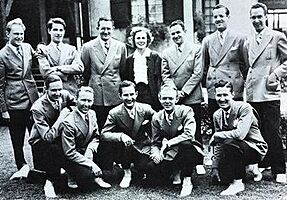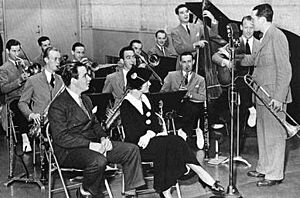The Dorsey Brothers facts for kids
Quick facts for kids
The Dorsey Brothers
|
|
|---|---|

The Dorsey Brothers Orchestra in 1934.
|
|
| Background information | |
| Origin | New York City, New York, U.S. |
| Genres | Jazz |
| Years active | 1928–1935 |
| Labels |
|
The Dorsey Brothers were a famous American jazz and dance band. It was led by two brothers, Tommy Dorsey and Jimmy Dorsey. They started making records in 1928 for OKeh Records.
Contents
The Dorsey Brothers: A Jazz Story
Early Days and First Recordings
The Dorsey Brothers first recorded songs for smaller record labels. These were sometimes called "dime store labels" because their records were sold cheaply. Some of these labels included Banner, Cameo, Domino, Jewel, Oriole, and Perfect. They also released some songs through Vocalion Records during their time with Brunswick Records.
In 1934, the band signed with Decca Records. They then formed a touring band, which meant they traveled around to perform live. Tommy Dorsey was the main leader on stage. Their band had a unique setup with one trumpet, three trombones, three saxophones, and four rhythm instruments. They mostly performed in the New England area.
Touring and the Big Split
As they toured, Tommy and Jimmy often disagreed. Their arguments grew until a big fight happened in May 1935. They argued about how fast a song called "I'll Never Say Never Again Again" should be played. After this argument, Tommy walked off the stage.
Glenn Miller, a famous musician, was part of the Dorsey Brothers band in 1934 and 1935. He wrote four songs for them: "Annie's Cousin Fannie", "Dese Dem Dose", "Harlem Chapel Chimes", and "Tomorrow's Another Day". Glenn Miller left the band in late 1934 to become a music director and arranger for Ray Noble.
In 1935, the Dorsey Brothers Orchestra had two songs that reached number one on the music charts. These included "Lullaby of Broadway", which featured Bob Crosby singing. This song was number one for several weeks.
Reunions and Television Fame
Tommy Dorsey left the orchestra for good in 1935. He took over another band, the Joe Haymes band, and renamed it "Tommy Dorsey and his Orchestra." The rest of the Dorsey Brothers' Orchestra continued with Jimmy Dorsey as the leader. A 16-year-old musician named Bobby Byrne took Tommy's place.
The brothers reunited on March 15, 1945, to record a special disc for soldiers during World War II. This disc included songs like "More Than You Know" and "Brotherly Jump." Both Jimmy's and Tommy's orchestras played together for these songs. They also reunited in 1947 for a movie about their lives called The Fabulous Dorseys.
In 1950, Jimmy stopped leading his own orchestra and joined Tommy's band permanently. Their combined orchestra first appeared on television on the Jackie Gleason Show in May 1953. Starting in 1954, they had their own TV show called Stage Show, which was produced by Jackie Gleason. A very famous singer, Elvis Presley, made his first national television appearance on their show in 1956.
Sadly, Tommy Dorsey passed away in his sleep in November 1956. Jimmy, who was already very ill, continued to perform for a few months. He would display Tommy's trombone on stage as a tribute. Jimmy Dorsey passed away in June 1957 from lung cancer.
Jimmy and Tommy also appeared as "Mystery Guests" on the TV show What's My Line? in October 1955. In 1996, the U.S. Postal Service created a special postage stamp to honor both Jimmy and Tommy Dorsey.
Famous Songs
Here are some of the notable songs released by The Dorsey Brothers:
- "Coquette", 1928
- "Dixie Dawn", 1928
- "Let's Do It (Let's Fall in Love)", (with Bing Crosby singing), 1929
- "Sally of My Dreams", 1929
- "Fine and Dandy", 1930
- "Ooh! That Kiss", 1932
- "Old Man Harlem", 1933
- "I'm Gettin' Sentimental Over You", 1934; Tommy Dorsey later used this as his theme song
- "Lost in a Fog", 1934
- "What a Diff'rence a Day Made", 1934
- "You're the Top", 1934
- "Annie's Cousin Fannie", 1934, written by Glenn Miller
- "Tomorrow's Another Day", 1935, written by Glenn Miller
- "Harlem Chapel Chimes", 1935, written by Glenn Miller
- "Chasing Shadows", 1935, No. 1 hit
- "Every Little Moment", 1935
- "Every Single Little Tingle of My Heart", 1935
- "I'll Never Say Never Again Again", 1935
- "I've Got a Feelin' You're Foolin'", 1935
- "Dese Dem Dose", 1935, written by Glenn Miller
- "Lullaby of Broadway", 1935, No. 1 hit
- "Night Wind", 1935
- "Solitude", 1935
- "The Gentlemen Obviously Doesn't Believe (In Love)", 1935
- "Tiny Little Fingerprints", 1935
- "You Are My Lucky Star", 1935
Band Members
Many talented musicians played with the Dorsey Brothers. Here are some of them:
- Mildred Bailey (vocals)
- Bunny Berigan (trumpet)
- Artie Bernstein (string bass)
- Buzz Brauner (tenor sax)
- Bing Crosby (vocal)
- Bob Crosby (vocal)
- Skeets Herfurt (alto sax)
- Roc Hillman (guitar)
- Alberta Hunter (vocals)
- Stan King (drums)
- Mannie Klein (trumpet)
- Carl Kress (guitar)
- Eddie Lang (guitar)
- Don Matteson (trombone)
- Johnny Mercer (vocals)
- Leo McConville (trumpet)
- Dick McDonough (guitar)
- Fulton McGrath (piano)
- Ray McKinley (drums)
- Glenn Miller (trombone, arranger)
- Chauncey Morehouse (drums)
- Phil Napoleon (trumpet)
- Adrian Rollini (bass sax)
- Arthur Schutt (piano)
- Frank Schumacher (clarinet, tenor sax)
- Glenn Stainer (tenor Sax)
- Frank Signorelli (piano)
- Charlie Spivak (trumpet)
- Jack Stacey (tenor sax)
- Joe Tarto (brass bass)
- Jack Teagarden (trombone)
- George Thow (trumpet)
- Bobby van Eps (piano)
- Joe Venuti (violin)
- Mae West (vocals)
- Joe Yukl (trombone)


